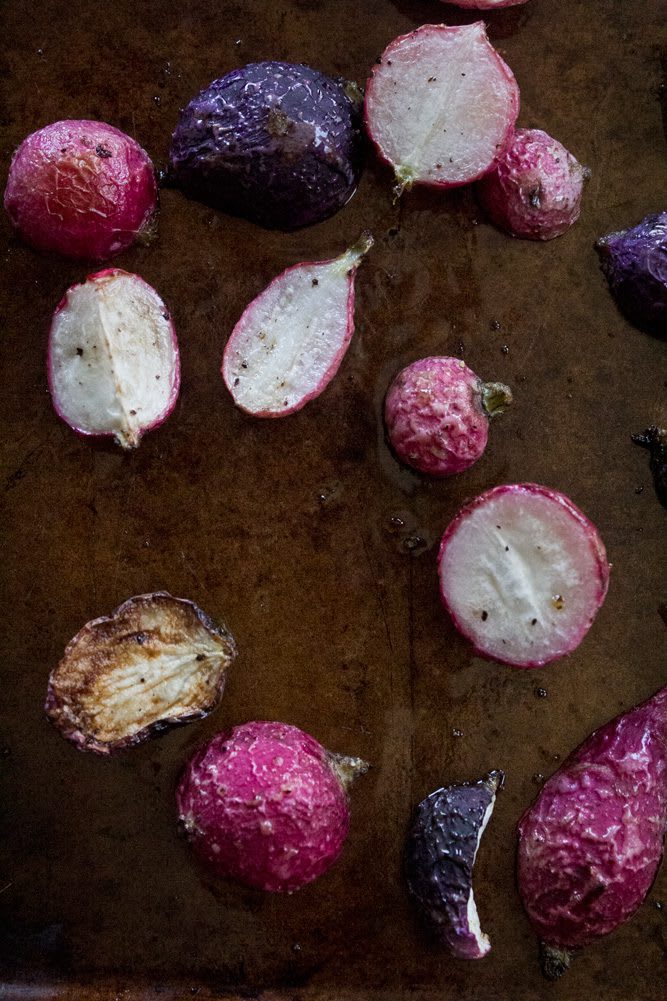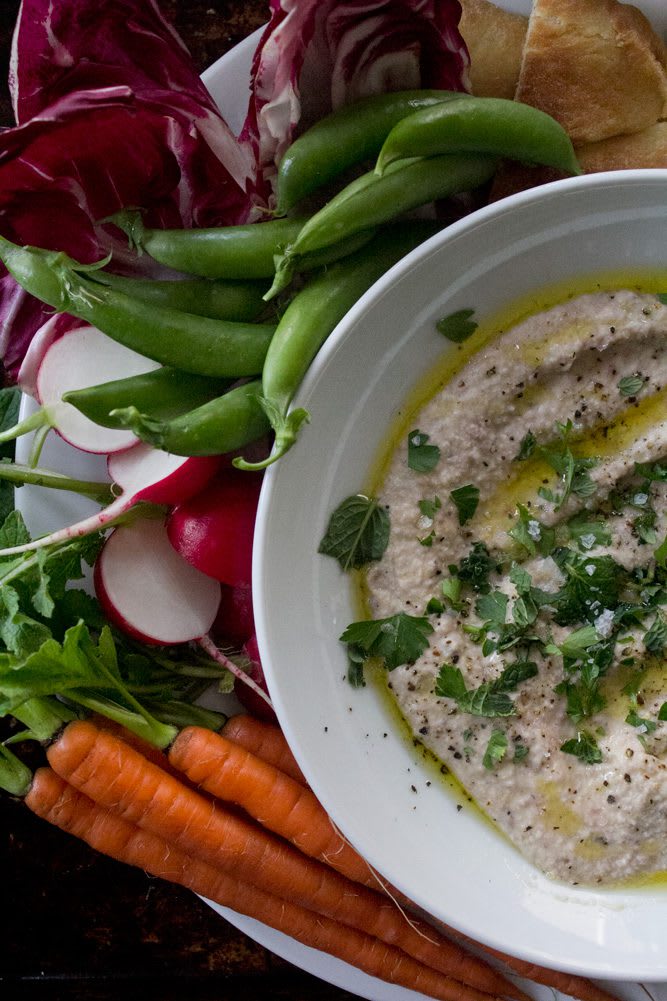52 Weeks of Hummus //Healthy //Herbs //Potager //Recipes
Roasted Radish Hummus
January 14
3 min read
5 Comments
Two heirlooms. One classic dip.
What do you get when you combine two heirlooms in one historic dish? Roasted radish hummus! Roasting the radishes brings out an earthy sweetness that goes well with fresh veggies or warm flat breads. If you’re lucky to have a little left over, it’s even delicious the next day with crispy kale and runny eggs.
The Modern Potager Kitchen Garden
The joy of the modern potager is getting to expand your culinary skills and make restaurant-quality meals at home. Picking fresh ingredients from the garden and turning them into something that awakens your tastebuds and thrills is really what life is all about.
It should come as no surprise that I have a high appreciation of historical foods as an heirloom gardener. One of the oldest and most historically relevant dishes in human history is hummus.
And I could eat hummus morning, noon, and night. On its own with fresh flatbreads, alongside eggs, or loaded with roasted veggies. It’s this love of hummus that led Matthew to adamantly state, “You cannot survive on hummus and cucumbers alone.” As we shared a plate of one of my favorite variations, roasted red pepper hummus, with fresh radishes, cucumbers, and herbs from the showcase garden, the challenge of his statement kept dancing in my mind.
While it made me laugh in the moment, the notion that I could not survive off such a healthy dietary staple sent me down a path of cultural exploration and adventures in the kitchen for weeks on end. I wanted to understand the lore surrounding hummus and its impact upon the world. And truth be told, I wanted to discover if one could survive on hummus without getting bored.
The Challenge Begins
In short, I’ve accepted the challenge to explore all that hummus has to offer in both traditional and new ways with the help of some fantastic local chefs, food bloggers, and a little creativity. Together, we’ll make a year’s worth of delicious hummus variations—52 hummus recipes that feature the best of seasonal produce and pantry essentials.
We’ll test various cooking techniques, discussing the pros and cons of each method to achieve multiple results. While some chefs swear by using dried chickpeas and removing the skins, today’s high-powered blenders make quick work of tinned beans with their skins intact.
THE HISTORY OF HUMMUS
The earliest known origins of hummus date back to the 13th century, with several cultures claiming the creation of the savory dip. Yotam Ottolenghi, chef and cookbook author, writes about the hummus wars in his book “Jerusalem: A Cookbook.” But Israel isn’t the only country where people argue over the best hummus recipe. Palestinians, Egyptian Arabs, Greeks, and other Middle Eastern and Mediterranean countries also declare hummus as their dish, each region adding its own nuances.
The essence of the classic hummus recipe are chickpeas, tahini, lemon juice, and salt. As cooking methods have changed over the centuries, the textural preferences and techniques used to create the creamiest dip have altered the base recipes.
RADISHES: A HISTORIC HEIRLOOM
Radishes originated in China, where even today wild forms of the radish can still be found. In prehistoric times, appreciation for the radish spread to Middle Asia where many different types were developed and soon after, radishes were being grown in the Mediterranean.
Before the pyramids were constructed, ancient Egyptian writing show that radishes were being cultivated. The ancient Greeks prized radishes so much that they made small replicas of them in gold. The Romans also were familiar with various forms of the radish.
The radish was one of the first vegetables introduced into the New World. Radishes were already under cultivation in Mexico in 1500 and in Haiti in 1565. The radish quickly caught on in the Americas where we still enjoy many of the heirloom varieties of our ancestors.


Roasted Radish Hummus
Makes approximately 1 1/2 cups of fresh hummus | 4 servings
Created from years of making hummus
Ingredients
1 1/2 cups hydrated garbanzo beans/chickpeas (this is approximately 1 can), drained (reserve water brine)
2 tablespoons tahini (sesame paste)
1 pound radishes, trimmed + cut in half
1 Lemon, cut for juice
1 small garlic clove, cut in half (if needed)
1 teaspoon fresh thyme
Sea salt + fresh cracked pepper
Swirl of olive oil (for roasting)
Small glug of really good extra virgin olive oil
Really good extra virgin olive oil
Flaky sea salt
Fresh cracked pepper
Mixed fresh herbs, finely chopped – thyme, mint, cilantro, and parsley
Instructions
1) Heat oven to 425F. Dress trimmed and halved radishes with olive oil and a sprinkle of sea salt and pepper. Next, roast for 10-15 minutes or until radishes start to turn golden. Remove and let cool.
2) Drain the hydrated garbanzo beans reserving the liquid to help thin the hummus, as needed. Place in a high-powered blender with tahini, juice from half the lemon, small garlic clove, roasted radishes, freshly cracked pepper and a pinch of sea salt. Blend at high speed until smooth, scraping down the sides if needed. If the mixture is not blending well, add 1-2 tsp of reserved bean liquid to help thin. Last, add one circle of olive oil (about 2 teaspoons) and blend.
3) Place hummus in a shallow bowl and dress with extra virgin olive oil, a sprinkling of flaky sea salt and freshly cracked pepper, and a mix of fresh garden herbs. This hummus is delicious with fresh thyme, mint, cilantro, parsley, and chives on top.
Serve with raw carrots, radicchio, sweet peas, fresh radishes, and warm flat breads. Delicious the next day with crispy kale and runny eggs.
[…] berries, brassicas, citrus, melons, potatoes, radishes, peas, stone […]
[…] Berries, Carrots, Chard, Eggplant*, Peppers*, Potatoes, Radish (in partial shade), Malabar Spinach*, […]
[…] Daikon, Endive, Kale, Lettuces, Mustard Greens, Onions, Parsnips, Potatoes, Radicchio, Radish, Scallions, Snow Peas, Spinach, Sugar Peas, Swiss […]
[…] Daikon, Endive*, Kale*, Lettuces*, Mustard Greens*, Onions, Parsnips, Potatoes, Radicchio*, Radish, Scallions, Snow Peas, Spinach*, Sugar Peas, Swiss Chard*, […]
[…] (after the 15th), Kale, Leeks, Lettuces, Mustard Greens, Onions (short- and medium-day), Potatoes, Radish, Scallions, Snow Peas, Spinach*, Summer Squash, Sugar Peas, Swiss Chard*, Tomatoes (start 2nd round […]